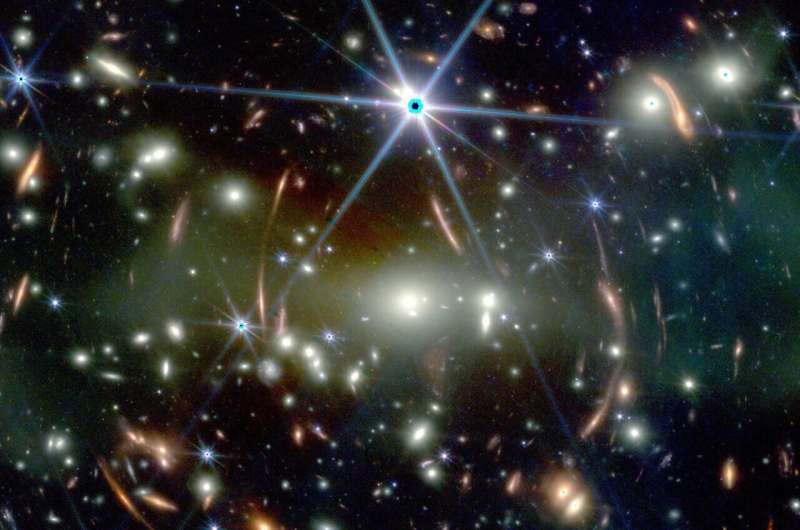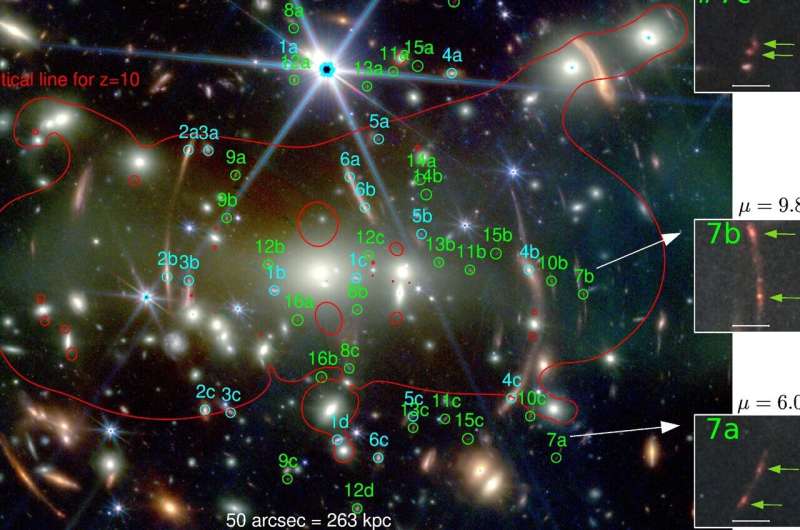This JWST image shows the galaxy cluster SMACS J0723.3−7327 with a large number of lensed background galaxies. The white bar at the bottom corresponds to 50 arcsec, which is approximately the maximum size of Jupiter observed from Earth. Credit: NASA, ESA, CSA and STScI
Using the first science image released by the James Webb Space Telescope (JWST) this month, an international team of scientists with significant contribution from the Technical University of Munich (TUM) has built an improved model for the mass distribution of the galaxy cluster SMACS J0723.3−7327. Acting as a so-called gravitational lens, the foreground galaxy cluster produces both multiple images of background galaxies and magnifies these images. One family of such multiple images belongs to a galaxy, which the model predicts to be at a distance of about 13 Gyrs, i.e., whose light traveled some 13 billion years before reaching the telescope.
The first science image released by the James Webb Space Telescope (JWST) was of a gravitational lens, in particular the galaxy cluster SMACS J0723.3−7327. Gravitational lenses, especially galaxy clusters, magnify the light from background galaxies and produce multiple images of these. Before JWST, 19 multiple images of six background sources were known in SMACS J0723.3−7327. The JWST data now revealed 27 additional multiple images from another ten lensed sources.
"In this first step towards the road opened by JWST, we used recent data from this brand new telescope, to model the lensing effect of SMACS0723 with great accuracy," points out Gabriel Bartosch Caminha, postdoc fellow at TUM, the Max Planck Institute for Astrophysics (MPA) and the German Center for Cosmological Lensing (GCCL). The collaboration first used data from the Hubble Space Telescope (HST) and Multi Unit Spectroscopic Explorer (MUSE) to build a "pre-JWST" lens model, and then refined it with newly available JWST near-infrared imaging. "The JWST imaging is absolutely astounding and beautiful, showing many more multiply lensed background sources, which allowed us to substantially refine our lens mass model," he adds.
In this image, the various multiply lensed background galaxies are numbered, with cyan colours indicating already known multiple image systems and green colours indicating new multiply lensed sources. The insets show enlarged images of a very distant galaxy with some substructure indicated by the green arrows. Credit: NASA, ESA, CSA and STScI (annotations by MPA)
One of the most accurate models available
Many of these new, lensed sources do not yet have distance estimates, and the scientists used their mass model to predict how far away these lensed galaxies are most likely to be. One of them was found to be probably at the amazing distance of 13 Gyrs (redshift > 7.5), i.e. its light was emitted during the universe's early stages. This galaxy is multiply lensed into three images and its luminosity is magnified by a factor of μ≈20 in total.
However, to study these primordial objects, it is fundamental to describe accurately the lensing effect of the foreground galaxy cluster. "Our accurate mass model forms the foundation for the exploration of the JWST data," emphasizes Sherry Suyu, Professor of Observational Cosmology at TUM, Max Planck Research Group Leader at MPA and a Visiting Scholar at the Academia Sinica Institute of Astronomy and Astrophysics. "The spectacular JWST images show a great variety of strongly lensed galaxies, which can be studied in detail thanks to our accurate model."
The new model for the mass distribution of the foreground cluster is capable of reproducing the positions of all multiple images with a high accuracy, making the model one of the most accurate available. For follow-up studies of these sources, the lens models, including magnification maps and redshifts (i.e., distances) estimated from the model are made publicly available. "We are very excited about this," Suyu adds. "We are eagerly awaiting future JWST observations of other strong lensing galaxy clusters. These will not only allow us to better constrain the mass distributions of galaxy clusters, but also to study high-redshift galaxies."
More information: G. B. Caminha et al, First JWST observations of a gravitational lens: Mass model of new multiple images with near-infrared observations of SMACS~J0723.3−7327. arXiv:2207.07567v1 [astro-ph.GA], arxiv.org/abs/2207.07567
Provided by Technical University Munich

























